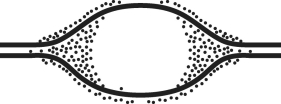In an experiment, DNA is allowed to replicate in an environment with all necessary enzymes, dATP, dCTP, dGTP, and radioactively labeled dTTP (³H thymidine) for several minutes and then switched to nonradioactive medium. It is then viewed by electron microscopy and autoradiography. The drawing below represents the results. 
Grains represent radioactive material within the replicating eye.
Figure 16.2
Which is the most likely interpretation?
A) There are two replication forks going in opposite directions.
B) Thymidine is only being added where the DNA strands are furthest apart.
C) Thymidine is only added at the very beginning of replication.
D) Replication proceeds in one direction only.
Correct Answer:
Verified
Q2: Polytene chromosomes of Drosophila salivary glands each
Q3: At a specific area of a chromosome,
Q5: The enzyme telomerase solves the problem of
Q6: In E. coli, there is a mutation
Q20: What is meant by the description "antiparallel"
Q29: Use Figure 16.1 to answer the following
Q34: Which of the following removes the RNA
Q36: What is the function of DNA polymerase
Q37: To repair a thymine dimmer by nucleotide
Q57: Once the pattern found after one round
Unlock this Answer For Free Now!
View this answer and more for free by performing one of the following actions

Scan the QR code to install the App and get 2 free unlocks

Unlock quizzes for free by uploading documents